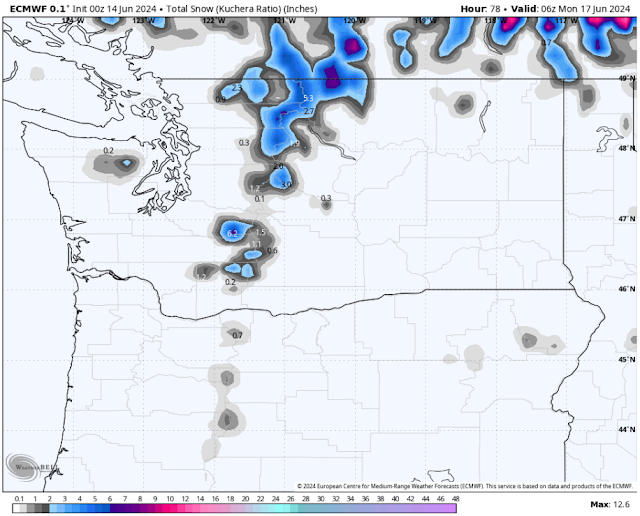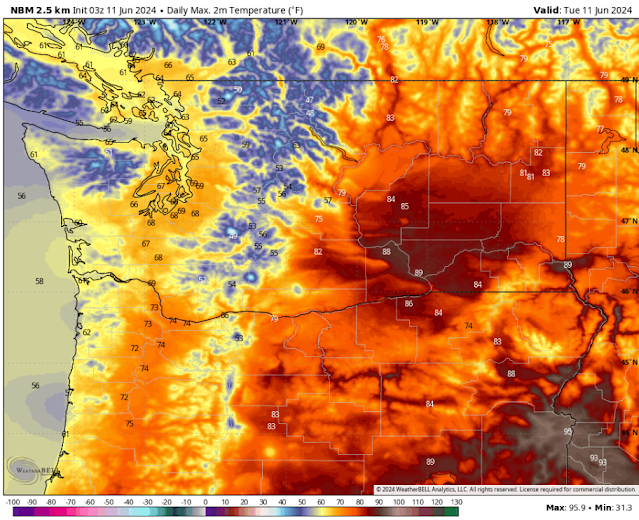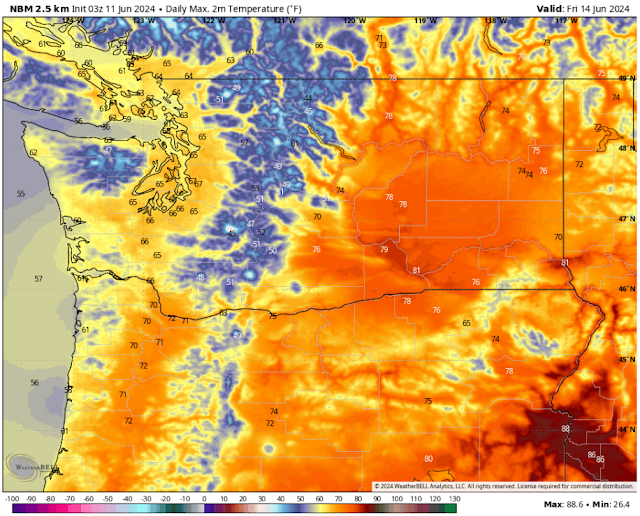FastCast--Sunday, June 30 to Thursday, July 4:
Relatively calm weather will continue over the next few days, with a potential heat wave looming around and after July 4th. From late Saturday through Sunday morning, there will be some showers around the region. Rain totals will likely be around 0.05-0.25", most north of Everett and on the northern coast. Showers will taper by Sunday morning, giving way to partly sunny conditions, with highs in the mid 70s. Monday, Tuesday, and Wednesday will follow a similar pattern, with morning clouds and afternoon sun, with cloud coverage decreasing each day. Highs will reach the mid 70s each day. Temperatures will begin increasing starting on the Fourth, with mostly sunny skies and highs reaching the low 80s. Similar warmth and sunny skies are likely over the ensuing days. Through the Fourth, expect overnight lows in the low to mid 50s.
Hurricane Beryl: Heading for the Lesser Antilles, Jamaica, Grand Caymans, potentially Yucatan Peninsula and Belize, peak strength likely 125 mph (Category 3)
Updated Information: National Hurricane Center -- Hurricane Beryl
-------------------------------------------------------------------
Continue reading the full blog below!
Brief showers are moving through the region this weekend, likely the last rain for the foreseeable future. The European model forecast below shows total rain through Sunday.
Most of the lowlands will receive 0.1-0.25", with similar amounts on the coast. The Blue Mountains and northern tier of the Cascades (across WA) could get up to 0.3-0.5".
Now, for the overall pattern, which will have a significant change as we go through the week. Below is the upper-air forecast for Sunday, from the European model.
Notice the very weak troughing over the Northwest (in this case, no blue shading for the troughing, just the subtle absence of a ridge). This is the pattern bringing lots of high clouds and the weekend showers.
This will completely change by the end of the week. Below is the same forecast for next Saturday.
This is a huge change! The Northwest is under a strong ridge, which will bring heat wave potential to the area, mainly from July 4th onward.
Let's take a look at the forecast for highs over the next few days, before looking at an extended forecast for the first half of July.
Below is the NWS NBM high-resolution forecast for Sunday.
On Sunday, expect lowland highs in the low to mid 70s, with the coast reaching the low to mid 60s, the Willamette Valley reaching the upper 70s to low 80s, and Eastern Washington reaching the upper 70s to low 90s (hottest around the Tri-Cities).
Next, let's take a look at Monday's forecast.
Monday is almost the exact same as Sunday, except only in the low 60s along the coast.
Next, here's Tuesday's highs.
Tuesday is very similar to Sunday and Monday, although it'll be a tad cooler around Portland, only in the mid to upper 70s.
Finally, here's a look at Wednesday's forecast. This is when a bit of a warmup will start, as the large and strong ridge builds.
On Wednesday, lowland highs will reach the mid to upper 70s (only in the low 70s for the North Sound). The coast will reach the mid 60s, and the Willamette Valley will be up to the low to mid 80s. Eastern Washington will reach the mid 80s to low 90s.
This is only the beginning of what looks to be a somewhat extended warm stretch for the Northwest. Below is the European Ensemble forecast for highs in the Seattle area over the next 14 days.
Notice how highs increase around July 4th and remain warm for the next week and longer. One thing to note is that these forecasts aren't very accurate after around 7-10 days, so the second half of the graphic is much less certain.
Stay tuned over the next few days as we start July and get closer to this potential heatwave!






















































